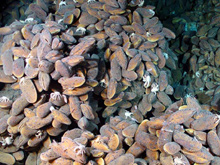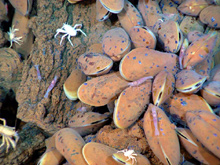
At NW Eifuku volcano, mussels are so dense in some places that they obscure the bottom. The mussels are ~18 cm (7 in) long. The white galatheid crabs are ~6 cm (2.5 in) long. Click image for larger view.
Magic Mussel Mounds Abound at
NW Eifuku Volcano
April 11, 2004
Verena Tunnicliffe
Canada Research Chair in Deep Oceans
Professor, University of Victoria, Canada
![]()
![]() See an extraordinary biological community of hydrothermal mussels at NW Eifuku volcano. (mp4, 4.9 MB)
See an extraordinary biological community of hydrothermal mussels at NW Eifuku volcano. (mp4, 4.9 MB)
![]() The hydrothermal mussels at NW Eifuku volcano's Cliffhouse vent. (mp4, 6.1 MB)
The hydrothermal mussels at NW Eifuku volcano's Cliffhouse vent. (mp4, 6.1 MB)
The geologists were complaining. They could not see the rocks through the massive piles of mussels. The biologists, however, were euphoric. A tremendous mussel biomass adorned the lava ridges at the crest of NW Eifuku volcano. They were attached by sticky threads (known as byssal threads) spun by each animal's foot. Other than being much larger -- these deep-sea mussels were up to 18 cm (7 in) long -- they were very similar to their intertidal cousins.
Mussels are found at hydrothermal vents and cold seeps around the world. They are part of the genus Bathymodiolus, first discovered at hot vents off western Mexico. While their presence here was not a big surprise, their density and the relative lack of other fauna were intriguing. Unlike elsewhere, these mussels were not residing in cracks or clustered around flowing vent water. Instead, they were clustered on the tops of rocks. As we searched for the venting source, billows of smoke wafted over the ridge. We located the Champagne smokers downslope from the mussels (see April 10 log), but there was no temperature anomaly in the water around the mussels.
What are the mussels feeding on? we wondered. Chemical analyses will tell us how much hydrogen sulphide and methane are in the water. It is likely that the mussels' gills house symbiotic bacteria that fix carbon, which the mussels may use as a source of energy. However, they are also capable of suspension feeding. We will examine their stomachs to see how much captured food is there.
The mussels are quite mobile, their long feet allowing them to move across the rocks. Once in position, they attach with their byssal threads. Their shells are covered with black “scars” where other mussels have attached, then detached and moved on. Upon collection, several mussels released eggs that sank to the bottom of the buckets. It is possible that larvae do not disperse far from the mussel bed. We saw no dead shells. This suggests that hydrothermal flow has remained constant during the years these mussels have grown and spread.

Galatheid crabs and shrimp graze on bacterial filaments on the mussel shells. The black "scars" on the shells are former anchor points of mussels who have cut their threads and moved on. Click image for larger view.

The vent mussel Bathymodiolus draws water through the siphons at its open end (left); its foot (right) extends and attaches to the rock with byssal threads. This mussel and its mates are ~18 cm (7in) long. Click image for larger view.
Other animals in the mussel bed included an alvinocarid shrimp and a galatheid crab. We watched both rapidly combing the mussel surfaces for bacterial filaments; the shrimp seemed to prefer areas of higher flow. Small snails and limpets occur in patches, and scale worms also appear to crop the bacteria. Unlike other vent mussels, these mussels harbored no commensal scale worms inside them.
Once again, the Mariana Arc volcanoes surprised us with a different type of assemblage. It is possible that NW Eifuku, which is some 1,000 m (more than a half-mile) deeper than the other sites visited on this expedition, forms a barrier to colonization by common species seen elsewhere. We hope to clarify the story at yet another volcano.
Sign up for the Ocean Explorer E-mail Update List.



























